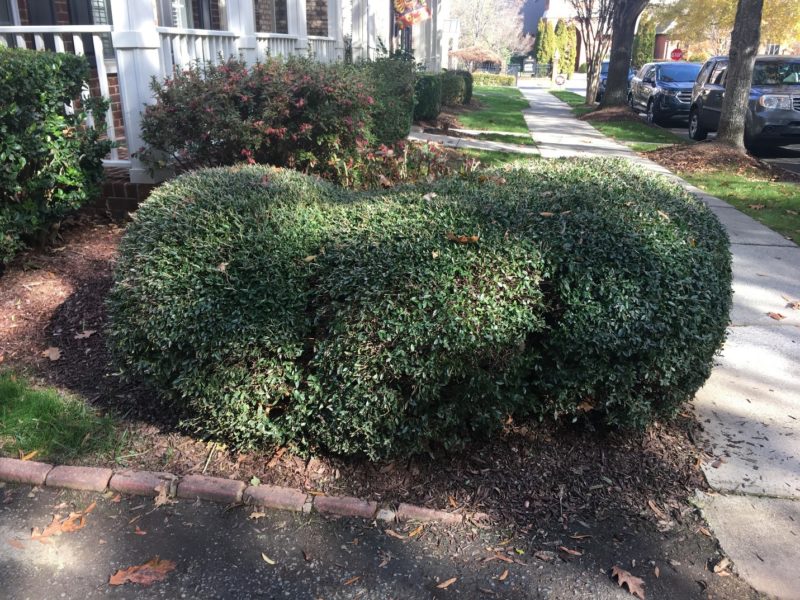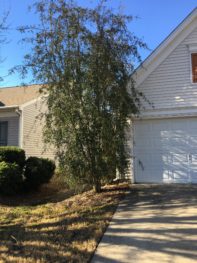GREEN AND GROWING
Yaupon Holly

A typical installation of “Nana” yaupon holly
November is the time to buy and plant yaupon holly (Ilex vomitoria). Yaupon is one of the most versatile native plants in use, having several cultivars that grow in a variety of useful habits, from small, dense shrubs similar to boxwood to small trees with weeping branches and several forms in between. In whatever form, it is a small leaved, evergreen plant. Curiously, its most striking attribute is rarely realized in Davidson. All yaupon hollies produce brilliant, semi-translucent red (in some cultivars, yellow or orange) berries in the late fall that persist, birds willing, until spring. This is the attribute so often missed. Most yaupons in Davidson are one of the dwarf varieties. For various reasons, the most commonly sold dwarf varieties rarely produce berries. If you want to see the berries, you will have to follow the advice below.
First, a few facts about Yaupon sex. Yaupon hollies, like all other hollies that I know about, grow either as male flower producing or female flower producing plants. There are no plants with both male and female flowers and no plants with both male and female parts in the same flower. Since berries and other fruits are only produced by flowers with female parts, in order to get berries, you must buy a female plant. Since few of us are skilled at distinguishing male from female flowers, you should buy your yaupons in late November, when the berries have matured, in order to see for yourself whether you have a female.

A mature male “Pendula” yaupon holly
Of course, females need the occasional male to fertilize their flowers. For every 3-5 female plants, you will need a male plant within about 50 feet so that in the spring, when flower fancies turn to love, bees can carry pollen from the male to the females to fertilize them. Since yaupons are so prevalent, especially in apartment and townhome complexes where the “Schillings” dwarf form is so common, there may already be a male plant nearby. But be careful, Schillings and Nana, which are not very floriferous anyway, are too often sheared into topiary meatballs several times a year. Goodbye flowers; goodbye pollen; goodbye berries. If you want to have berries on a dwarf yaupon holly then you must first purchase one of the heavy berry producing varieties such as “Carolina Ruby” or “Taylor’s Rudolf”; second, you need to ensure a close at hand male suitor; and lastly, none of these plants can be sheared.
The most common tree form variety is “Pendula.” This grows into a small evergreen tree 10- 20’ tall and 8-12’ wide. It comes in both male and female forms, so choose your plants in November. As the name suggests, it has drooping or “weeping” branches. It makes a great specimen or tall hedge.
“Pride of Houston” grows into an upright, multi-stemmed small tree. And again, it makes a great specimen, screen or hedge.
“Nana” is the most commonly planted yaupon in Davidson. Because it has small dark green leaves, grows slowly, and has a densely twiggy, habit that takes well to shearing, it is frequently used as a boxwood substitute. Like all the dwarf forms, it has a naturally mounded form. Although a female cultivar, it produces very few flowers; I have never seen berries on one. Its typical, unmolested size is 4-7’ tall by up to 10’ wide. Usually, however, it is clipped to a much smaller size.
“Schillings” (or “Stokes Dwarf”) is less frequently planted but is said by many experts to be superior to Nana. It grows to a slightly smaller size, more like 2-3’ tall and 3-4’ wide. Schillings is a male cultivar.
“Carolina Ruby” is a female dwarf cultivar and produces copious red berries if suitably fertilized and maintained. It grows to become about 4’ tall by 4’ wide.
“Taylor’s Rudolph” is the last cultivar I’ll mention. It, too, is a low-growing dwarf with a fine texture, plenty of red berries in fall, and glossy dark green leaves all year long.
All yaupon hollies tolerate wet feet but will also tolerate dry soil once established. They prefer acidic soil and thrive in partial shade to full sun. Shade diminishes berry production. The one drawback to this plant is that all cultivars grow suckers and will turn into a thicket, if not controlled. Fortunately, this is easy to manage.
Tom Watson
Tom Watson is a Volunteer Extension Master Gardener in Mecklenburg County. He has also received a Certificate in Native Plants from UNC-C and a Certificate in Horticulture Technology--Residential Landscape Design from CPCC. He and his wife, Sue Bartlett, own The Cedars Davidson Bed & Breakfast.


